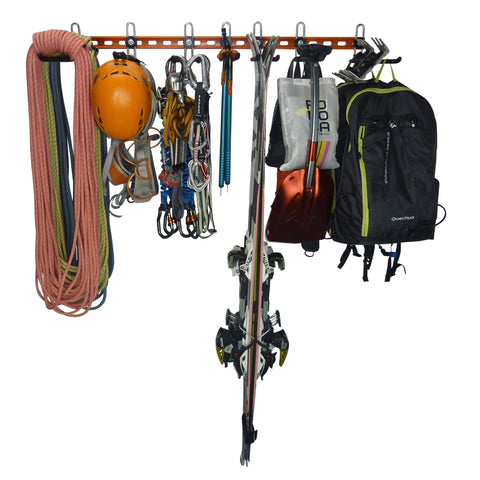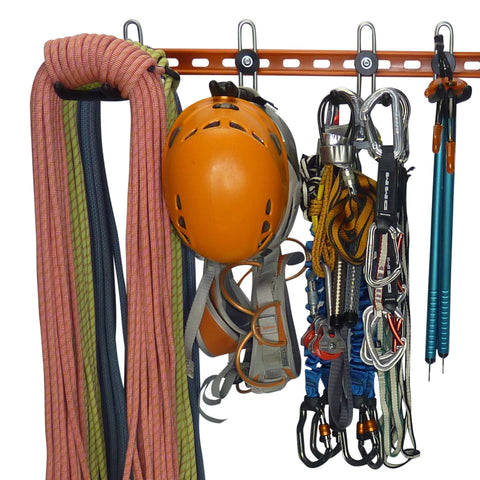
Rope Access - The Art of Proper Equipment Storage
Share
Rope access is a vital technique used across various industries such as construction, maintenance, and rescue operations. The safe and effective use of rope access equipment depends not only on its proper utilization but also on its adequate storage. In this comprehensive guide, we will delve into the best practices for storing rope access equipment to ensure its longevity, functionality, and safety.
GearHooks are one of the few (if not the only) company in the world that designs and manufactures storage racks for rope access gear including ropes, harnesses, helmets and all the other associated climbing and rope access equipment.
We manufacture all of the components and complete racks in the UK and are so confident of the strength and quality of the products that we provide a free lifetime warranty on everything we make.
Click here to see the standard products but bear in mind that, as the designer and manufacturer, we can change the layout of a rack to suit you ( perhaps with hooks for just ropes, or just helmets) and even design special storage hooks if necessary.
Here are some general tips on the Art of Proper Equipment Storage;
1. Clean and Inspect Your Gear
Before storing your rope access equipment, it is of utmost importance to clean and inspect it thoroughly. Begin by removing any dirt, debris, or contaminants that may have accumulated during use. Gently wash the items with mild soap and water, paying special attention to rope surfaces, connectors, and carabiners. Once cleaned, allow the equipment to air dry completely before proceeding.
2. Separate and Organize with Precision
Proper organization is key when it comes to storing rope access equipment. Arrange your gear systematically by separating different categories such as ropes, harnesses, helmets, and connectors. Separate hooks on our racks encourage this.
This segregation not only fosters easy access to the required items but also prevents tangling or damage. Consider investing in storage racks that are specifically designed for climbing and mountaineering equipment, like the high-quality options available at GearHooks.com. These racks offer secure and space-efficient storage solutions, ensuring your equipment remains in top-notch condition.
What equipment can be stored on a GearHooks rack?
The hooks on a GearHooks rack all have two prongs with different gaps between them. This allows ropes, for instance, to be hung over both prongs. Smaller parts, like carabiners, can be threaded onto separate prongs. Some specialist equipment, like skis or ice axes, can be hung between prongs.
The hooks on a standard rack are 300mm long which means you can get lots of gear on each hook, like 3 ropes, 6 helmets or 20-30 carabiners, one behind the other. This allows a lot of gear to be stored in a very small space but keeps it all easily accessible to use or inspect.
The racks are designed to be very adaptable so the following are just some of the things that can be stored on a GearHooks rack.
Ropes: Dynamic and static ropes are essential for rope access work. Static ropes are used for primary support and dynamic ropes for backup or safety lines. Ropes come in different lengths and diameters to suit various tasks. Three ropes can be hung on padded hooks and you get 1 or 2 of these on each rack.
Harness: A full-body harness is worn by the technician and serves as the attachment point for ropes and other equipment. It distributes the weight and provides support during work at heights.
Carabiners: Carabiners are used to attach ropes and other hardware to the harness and anchor points. They come in various shapes and designs, such as screw-lock, auto-lock, and non-locking.
Descenders: Descending devices control the rate at which a rope is paid out during descent. Common types include figure-eight descenders, rack descenders, and mechanical devices like the Petzl GriGri.
Ascenders: Ascending devices are used to move up a rope. They grip the rope when pressure is applied and slide freely when released. Examples include the Petzl Ascension and the Croll chest ascender.
Pulleys: Pulleys are used to redirect ropes, change their direction, or create mechanical advantage systems for lifting heavy loads. Prusik-minding pulleys are commonly used in rope access.
Anchor Points: Secure anchor points are crucial for attaching ropes and providing stable support. These can include natural features like beams or trees, or specially designed anchors such as bolts, slings, and straps.
Helmets: Helmets protect against head injuries from falling objects or impacts during rope access work. They often have attachments for headlamps and communication devices.
Gloves: Gloves protect the hands from abrasion, cuts, and burns while working with ropes and other equipment. They should provide dexterity and grip.
Footwear: Appropriate footwear, such as specialized climbing or work boots, provides traction and support when working on vertical surfaces.
Safety Lanyards: Lanyards with shock absorbers are used as secondary connections between the harness and the anchor point. They absorb energy in case of a fall.
Rescue Equipment: This includes items like rescue kits, stretchers, and hauling systems used in emergency situations to evacuate a worker or assist in a rescue.
Tool Bags: Technicians often carry tool bags or pouches to hold small tools and equipment needed for their specific tasks.
Communication Equipment: Two-way radios or communication systems are essential for maintaining contact between team members and for emergency situations.
Personal Protective Equipment (PPE): In addition to harnesses, helmets, and gloves, PPE can include safety glasses, ear protection, and clothing suitable for the specific work environment.
First Aid Kit: A basic first aid kit should be readily accessible in case of minor injuries.
Backpacks or Gear Bags: These are used to transport and store equipment, ensuring it remains organized and protected.
Fall Arrest Systems: Fall arrest systems, including energy-absorbing lanyards and shock absorbers, are crucial for worker safety in case of a fall.
3. Implement Gear Maintenance and Inspection Logs
Implementing a gear maintenance and inspection log is crucial for maintaining the safety and functionality of your rope access equipment. Create a comprehensive system where you can document each item's condition, its last inspection date, and any maintenance or repairs performed. Regularly review and update this log to track equipment usage, identify potential issues, and schedule inspections and replacements as needed. A diligent approach to gear maintenance will significantly enhance the overall safety of your operations.
4. Store in a Clean and Dry Environment
The storage environment for your rope access equipment plays a pivotal role in preventing damage caused by moisture, dust, or chemical exposure. Choose a storage area that is clean, dry, and well-ventilated. Ensure that the space has controlled temperature and humidity levels, avoiding excessive heat or cold. Keep the equipment away from direct sunlight and any harsh chemicals that could compromise its integrity. By providing the ideal storage conditions, you can enhance the longevity of your gear and minimize the risk of degradation.
5. Shield Your Equipment from UV Exposure
Extended exposure to ultraviolet (UV) light can weaken ropes and degrade other components of your rope access gear. To safeguard your equipment from UV damage, consider storing it in protective bags or cases made from UV-resistant materials. If storing outdoors is unavoidable, utilize covers or tarps to shield the gear from direct sunlight. Remember, adequate protection against UV exposure is essential for maintaining the strength and integrity of your equipment.
6. Regularly Rotate and Inspect Stored Equipment
Even when not in active use, regular inspections of stored rope access equipment are crucial. Periodically rotate the equipment to ensure equal usage of all components and prevent any section from deteriorating due to long-term static storage. During inspections, meticulously check for signs of wear and tear, aging, or damage. Promptly replace any compromised gear to maintain optimal safety standards.
By following these best practices, you can ensure that your rope access equipment remains in optimal condition, ready for use when required. Remember, proper storage and maintenance are just as vital as using the equipment correctly during rope access operations. Embrace these guidelines and take the necessary steps to preserve your gear's lifespan and guarantee the safety of everyone involved.
GearHooks are market leaders in rope access equipment storage so if you need any help or advice about storing your equipment, please get in touch.
Further Reading
If you are new to this field you might find the following sections useful.
What is industrial rope access
Industrial rope access, often simply referred to as "rope access," is a specialized method of working at heights or in challenging and difficult-to-reach locations using ropes and associated equipment. It is primarily employed in industries where traditional access methods like scaffolding, cranes, or aerial work platforms are either impractical or cost-prohibitive. Rope access technicians, also known as rope access workers or practitioners, use a combination of ropes, harnesses, anchors, and specialized tools to perform a wide range of tasks at elevated or remote locations. Here are key aspects of industrial rope access:
Versatility: Rope access can be applied in various industries and environments, including construction, maintenance, inspection, and repair work on structures like buildings, bridges, towers, dams, wind turbines, and offshore oil rigs.
Safety: Safety is a paramount concern in industrial rope access. Technicians undergo rigorous training and certification to ensure that they are proficient in rope access techniques and safety procedures. They use redundant safety systems to minimize the risk of falls.
Efficiency: Rope access is often more cost-effective and efficient than traditional access methods. It requires minimal setup time and can access hard-to-reach areas without the need for extensive scaffolding or equipment.
Minimal Environmental Impact: Rope access minimizes environmental disruption compared to using heavy equipment or scaffolding, making it an eco-friendly option in some cases.
Non-Destructive: Rope access work is typically non-destructive, meaning it doesn't cause damage to the structures being worked on, making it suitable for inspections and maintenance.
Wide Range of Applications: Rope access is used for a wide range of tasks, including window cleaning, painting, welding, structural inspections, concrete repairs, geotechnical surveys, and more.
Certification and Standards: Various organizations, such as the Industrial Rope Access Trade Association (IRATA) and the Society of Professional Rope Access Technicians (SPRAT), have established standards and certification programs for rope access workers to ensure safety and competence.
Rigorous Planning: Every rope access job involves careful planning and risk assessment. Technicians must determine the appropriate anchor points, equipment, and safety measures for each specific task.
Emergency Response: Rope access teams are trained in rescue techniques and are equipped to respond to emergencies, including self-rescue and the rescue of fellow workers in case of accidents.
Regulations: Rope access work is subject to industry-specific regulations and safety standards. Compliance with these standards is essential to ensure the safety of workers.
Overall, industrial rope access is a versatile and safe method for accessing elevated or difficult-to-reach areas for various industrial and commercial purposes. Its efficiency, cost-effectiveness, and minimal environmental impact make it a preferred choice for many applications where traditional access methods are impractical or less efficient.
What kind of jobs require industrial rope access
Industrial rope access is a specialized method of working at heights or in difficult-to-reach locations using ropes and associated equipment. It's primarily utilized in industries where traditional access methods like scaffolding or cranes are impractical or cost-prohibitive. Here are some jobs and industries that often require industrial rope access:
Construction and Building Maintenance: Rope access technicians are employed to perform tasks such as building inspections, window cleaning, facade repairs, and painting on high-rise structures.
Oil and Gas Industry: Offshore oil rigs and platforms require regular maintenance and inspection. Rope access is often used for tasks like welding, painting, and equipment installation.
Wind Energy: Wind turbine maintenance and blade repair are common applications for industrial rope access in the renewable energy sector.
Mining: Rope access is employed in underground mines for tasks like shaft inspections, rock scaling, and equipment installation.
Bridge Inspection and Maintenance: Engineers and technicians use rope access to inspect and repair bridges, including the undersides and hard-to-reach areas.
Telecommunications: Telecommunication towers and antennas need maintenance and repair work, which often involves rope access techniques.
Power Generation: Rope access is used in power plants for tasks like boiler inspections, chimney maintenance, and cooling tower repairs.
Civil Engineering: Civil engineers may employ rope access for geotechnical surveys, concrete repairs, and dam inspections.
Rescue Operations: Rope access technicians are trained in rescue procedures and can be called upon in emergency situations, such as confined space rescues or high-angle rescues.
Film and Photography: In the entertainment industry, rope access is used for filming in challenging locations or creating special effects.
Facade Cleaning: Cleaning and maintenance of tall buildings' facades, especially in urban areas, often require rope access techniques.
Environmental Services: Ecologists and environmental scientists use rope access to access remote or elevated areas for research and data collection.
Maritime and Shipping: Ship maintenance and inspection, especially in areas like hulls and rigging, may require rope access methods.
Emergency Services: Firefighters and search and rescue teams may use industrial rope access to reach individuals in dangerous or hard-to-reach locations.
Agriculture: In agriculture, rope access can be used for tasks such as pruning tall trees or inspecting equipment.
These jobs typically require technicians to undergo specialized training and certification to ensure their safety and competence while working at heights or in challenging environments. Industrial rope access has become a valuable tool in various industries due to its versatility and cost-effectiveness compared to traditional access methods.
GearHooks are market leaders in rope access equipment storage so if you need any help or advice about storing your equipment, please get in touch.



